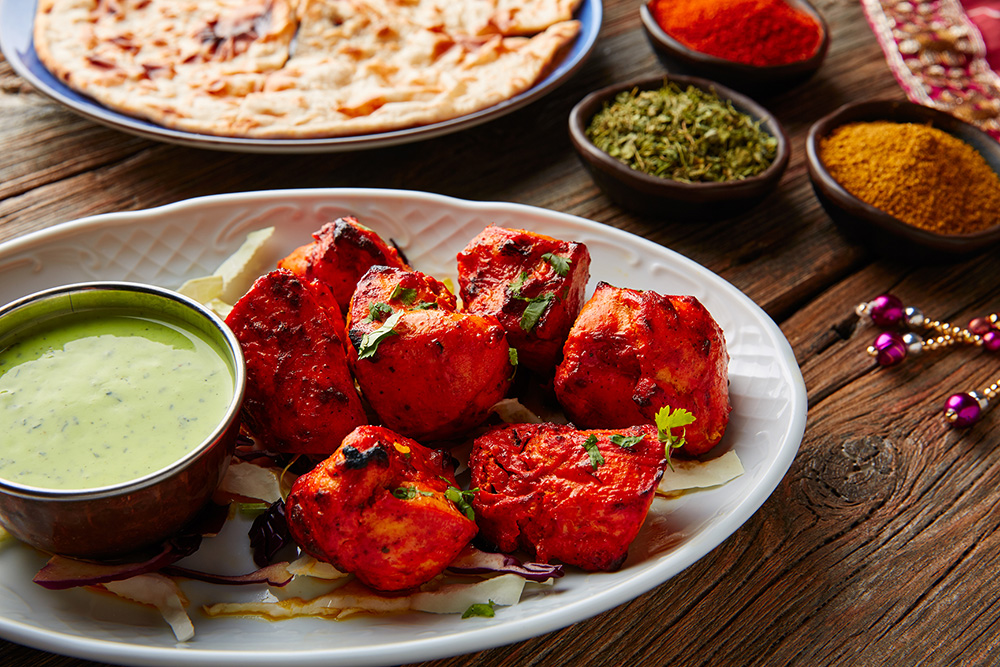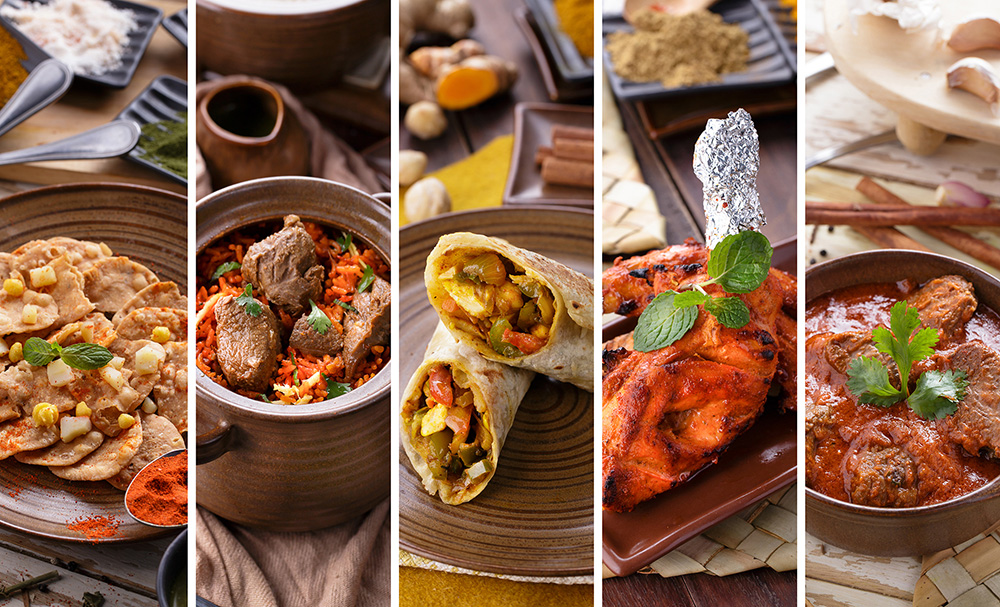Indian food is a more recent addition to the culinary scene in Canada, having gained prominence primarily in the post-1960s era of immigration. It is characterized mainly by the Northern Indian approach to cuisine, which features breads and warm curries and the use of yogurt and cream in meat-based dishes. But it also bears the influence of South Indian cooking, which frequently plays with the combination of sour and spicy and the use of tamarind and chilies. However, many typical Indo-Canadian dishes, such as kedgeree and some chutneys, are a product of Anglo-Indian cuisine stemming from Britain’s colonial rule of the Indian subcontinent.
See also Popular Indian Dishes in Canada.

Background: Indian Immigration to Canada
Estimates place the arrival of the first South Asian migrants to Canada in 1902 or 1903, arriving in Vancouver and hailing from Punjab. Although Indian immigrants, mostly single men, enjoyed some initial success, the eruption of anti-Asian race riots and subsequent legislation slowed the flow of migration from the South Asian subcontinent. In 1908, the Canadian Parliament passed legislation requiring migrants from India to arrive via a single continuous journey from their homeland. The result was a steep decline in immigration from the Indian subcontinent (see also Komagata Maru).
The change in Canadian immigration to a points-based system in the 1960s saw a dramatic increase in the number of Indian immigrants (see also Immigration Policy in Canada). Since the 1970s, Indians have come to Canada in increasing numbers from elsewhere in the diaspora, including East Africa and the Caribbean (see also: African Canadians; Caribbean Canadians). The vast majority of Canada’s Indian population remains settled in British Columbia or Ontario, where they make up a sizeable minority.
North Indian and South Indian Food: Key Differences
North Indian cuisine forms the basis of the Western experience with Indian restaurants. Heavily influenced by Central Asian cooking, North Indian cuisine is dominated by breads and warm curries. This, combined with the use of yogurt and cream in the often meat-based dishes, is largely responsible for Indian cuisine’s reputation in the West as a comfort food. Warm, spiced masala chai, sweetened with cinnamon and other spices, often ends a meal.

By contrast, South Indian cuisine is a more recent addition to the culinary scene in Canada, having gained prominence primarily in the post-1960s era of immigration. The most notable difference is the level of spice; South Indian cuisine plays much more frequently with the combination of sour and spicy, using tamarind and chilies in great quantities. The meals are based around rice more than bread — although both are often offered at North Indian style restaurants in Canada — and feature lentils and stews as the most common elements. A South Indian restaurant might feature dosa, (a crepe made from rice flour), idli (steamed lentil rice cakes) and sambar (a lentil and vegetable stew). South Indian meals are also more likely to use coconut and coconut milk as an ingredient instead of cream or yogurt.
Indian Food in Britain
Some of the first restaurants to serve Indian cuisine outside India were in Britain. The first Indian restaurant in London opened in 1810. The British East India Company often hired Indian men to work as sailors on fixed-term contracts. When their contracts expired, many of these men were unable to return home, either because they couldn’t afford the return passage or because their captains refused to take them, hoping to force them to work another term. As a result, these men were among the earliest Indian immigrants to Britain, which also included domestic servants who came with Anglo-Indian families returning to Britain. In keeping with their status as domestic servants, many of these men and women went into catering and restaurant work.

The food in these restaurants was often Anglo-Indian cuisine, a hybrid produced by Indians for their British employers in India. Dishes like kedgeree, various chutneys or mulligatawny soup employed Indian cooking techniques or spicing as a twist on more customary British cuisine. These dishes were brought to Britain as an element of colonial nostalgia by the British who had lived in India, and also served as a point of introduction for those who had never been.
After the Second World War, many Indian families who had come to Britain to fill the labour shortage converted damaged or abandoned pubs into restaurants. They served curries until the early morning hours after pubs had closed in order to catch extra business, and became widely popular beginning in the 1960s. Since then, Indian food has been an integral part of the British food scene, and curry is considered a quintessentially British dish.
Early Indian Restaurants in Canada
Generally speaking, the history of Indian food in Canada follows patterns established in Britain, but with some idiosyncrasies specific to the history of South Asian immigration to Canada. Many of the first South Asian immigrants to Canada were single, male migrant workers who lived and worked in camp settings in the logging and canning industries. Due to the semi-permanent and isolated nature of these camps, diets were based on commissary stores run by the logging companies or other similar arrangements, rather than a separate industry catering to the foods the immigrant workers were accustomed to.

However, beginning in the 1960s and 1970s, emigration from South Asia increased and the first groceries and restaurants run by Sikhs and other Indians began to appear in Canada. As communities blossomed in Vancouver and Toronto in particular, grocers and other food establishments rushed to fill the gap. Although Indian restaurants generally retained a heavy emphasis on North Indian cuisine due to the preponderance of Punjabi immigrants, waves of Indians from other parts of the diaspora began to diversify the offerings, from the Northern-influenced traditions of Indo-Caribbean immigrants to the Southern-influenced traits of East African Indians. The result is the highly diverse contemporary offerings at present.
Contemporary Indian Cuisine in Canada
Canada’s larger cities boast a wealth of Indian cuisine. The increasing interest in multiculturalism, the freedom of newcomers to preserve their heritage and the desire to acquire economic stability have resulted in many South Asian immigrants opening restaurants and other culinary businesses following their arrival. Canada’s legacy as a British colony has influenced the availability of Indian food not just by way of immigration policies, but also through conditioning the desires of the Anglo-Canadian palate. For example, some typical dishes in Indo-Canadian restaurants, such as kedgeree and chutneys, find their origin in the tradition of Anglo-Indian cuisine brought from India by colonial officials in the 18th and 19th centuries. This is juxtaposed by the highly varied and regionally specific offerings found largely in the suburban areas surrounding Toronto and Vancouver.

Furthermore, the thriving ethnic communities in the suburbs of Toronto in particular have led to the creation of a number of specialized grocers and restaurants that cater to the culture of the local clientele; from Goan (dishes that combine local ingredients of Goa with foods introduced by the colonial rulers from Portugal) to Hakka cuisine (a style practiced by a lineage of Han Chinese people), and from dosato palakpaneer (a purée of spinach and cheese curd). Further immigration from South Asia has also led restaurant owners to both diversify and specialize their selection in order to distinguish themselves from other eateries. Additionally, a burgeoning interest in travel, and travel for food specifically, has attracted curious eaters from outside the region, which in turn has resulted in the sometimes milder spicing and standardization of dishes being offered.
In Vancouver, where chef Vikram Vij has been a leading influence, the higher demographic of Sikhs from Indian and Pakistani Punjab has led to a more standardized set of offerings that lean towards Northern Indian cuisine. This scenario parallels the situation in downtown Toronto, where there is a less diverse offering akin to what might be available in the average Indian restaurant in Britain.

Stereotypes of Indian Cuisine
Similar to British restaurants, Indian establishments in Canada often use decor and staff uniforms to signal their authenticity, playing on customers’ expectations of exotic, spicy food and a colonial past. This harkening to the era of India’s colonial rule may be one reason for the simplification of the cuisine into “North” and “South” rather than allowing for multiple regional specialties.
Another complicating factor is that the generally low price point of Indian food has come to be expected in Britain and North America, given Indian establishments’ frequent function as takeout restaurants. This low-cost expectation can be particularly challenging considering the labour-intensive preparation of Indian cuisine. Furthermore, the popular perception of Indian food as cheap and even greasy has often reinforced the racial perceptions and social conditions that forced many South Asian immigrants into the food business in the first place. Indian cuisine is still rarely represented among the haute cuisine offerings in either Britain or Canada. Instead, it is more common to see high-end restaurants use Indian flavours and techniques to produce variations on classic European dishes than to offer Indian food at a more expensive price point.

 Share on Facebook
Share on Facebook Share on X
Share on X Share by Email
Share by Email Share on Google Classroom
Share on Google Classroom



